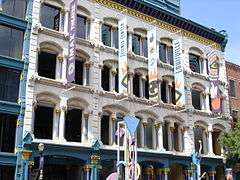Art Sparks Interactive Family Gallery
The Laramie L. Leatherman Art Learning Center, colloquially known as the Art Sparks Interactive Family Gallery, is the children's center at the Speed Art Museum in Louisville, Kentucky, United States. The 4,500-square-foot (420 m2) space opened in 1997 to serve as an interactive introduction to art and the museum's collection.
The Interactive Gallery was designed to foster shared and personal memories, and confidence through responsible interactivity by young children within a museum environment.[1] The facility was created in accords with new research of child pedagogy, neural development, and informal learning.
With a $50 million expansion planned through 2015, Art Sparks is closed while the museum undergoes construction. The new 60,000-square-foot North Building will double the overall square footage and nearly triple the gallery space from the existing wing. The expansion will create a space for larger special exhibitions, new contemporary art galleries, a family education welcome center, indoor/outdoor café, museum shop, and a pavilion for performances, lectures and entertaining. Additionally, the new Elizabeth P. and Frederick K. Cressman Art Park and public Piazza will be created for the display of sculpture.
Methodology
Children in the space use sensory play to explore art and ideas. The space was influenced by approaches including Reggio Emilia, which is child-centered and with an emphasis on materials, the Waldorf education method, with materials to allow things to evolve and Howard Gardner's Theory of multiple intelligences, and Mihaly Csikszentmihalyi's theories of Flow (psychology).
Floor plan
Criticis interactive learning approaches often say that interactivity over-stimulate children and potentially makes them too excited to absorb the experiences.[2] In working through the floor plan of exhibits, the Art Sparks Interactive Family Gallery has arranged strategically.
The layout of the gallery space modulates around a balance of "cool," "warm," and "hot" activities which helps families avoid over-stimulation.[3]
- Cool: quiet, focused, and cognitive activities: puzzles and building activities
- Warm: interpersonal activities that multiple people can do together
- Hot: very active activities that are either kinesthetic, or involve media or software.
Transitional zones ease the visitor from the traditional, non-touch galleries into the participatory galleries. For example, the Speed's Harmonic Sound Corridor allows the visitors' bodies to trigger a sequence of sounds and harmonic semitones based on movement.
See also
References
- ↑ Adams, Mariana; Moreno, Cynthia; Polk, Molly; Buck, Lisa. The Dilemma of Interactive Art Museum Spaces. Art Education (September 2003) 42-52.
- ↑ Adams, Marianna, Jessica Luke, and Theano Moussouri. "Interactivity: Moving Beyond Terminology," Curator: The Museum Journal, Vol. 47 No. 2, (2004): 155-170.
- ↑ Adams, M. and T. Moussouri. 'The interactive experience: linking research and practice' Paper presented at the Victoria & Albert Museum International Conference Interactive Learning in Museums of Art and Design, 17–18 May 2002 http://www.vam.ac.uk/vastatic/acrobat_pdf/research/adams_moussouri.pdf



